Begonia
Begonia is a genus of perennial flowering plants in the family Begoniaceae. The genus contains more than 1,800 different plant species. The Begonias are native to moist subtropical and tropical climates. Some species are commonly grown indoors as ornamental houseplants in cooler climates. In cooler climates some species are cultivated outside in summertime for their bright colourful flowers, which have sepals but no petals.
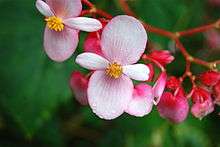
| Begonia | |
|---|---|
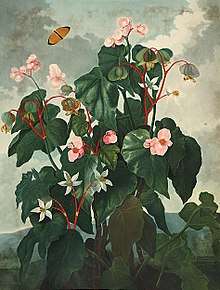 | |
| Begonia obliqua | |
| Scientific classification | |
| Kingdom: | Plantae |
| Clade: | Tracheophytes |
| Clade: | Angiosperms |
| Clade: | Eudicots |
| Clade: | Rosids |
| Order: | Cucurbitales |
| Family: | Begoniaceae |
| Genus: | Begonia L. |
| Type species | |
| Begonia obliqua L. | |
| Species | |
 | |
| Range of the genus Begonia | |
| Synonyms | |
|
List
| |
Description
With 1,831 species, Begonia is one of the largest genera of flowering plants.[1][2] The species are terrestrial (sometimes epiphytic) herbs or undershrubs, and occur in subtropical and tropical moist climates, in South and Central America, Africa, and southern Asia. Terrestrial species in the wild are commonly upright-stemmed, rhizomatous, or tuberous. The plants are monoecious, with unisexual male and female flowers occurring separately on the same plant; the male contains numerous stamens, and the female has a large inferior ovary and two to four branched or twisted stigmas. In most species, the fruit is a winged capsule containing numerous minute seeds, although baccate fruits are also known. The leaves, which are often large and variously marked or variegated, are usually asymmetric (unequal-sided).
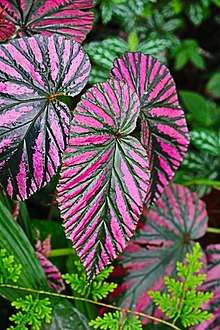 Begonia brevirimosa
Begonia brevirimosa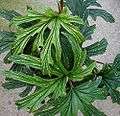 Begonia aconitifolia
Begonia aconitifolia A flowering begonia
A flowering begonia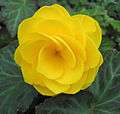 Begonia cultivars come in many different colours, such as yellow
Begonia cultivars come in many different colours, such as yellow A begonia leaf
A begonia leaf A pair of blossoms, male and female
A pair of blossoms, male and female A nautilus-leaf form of begonia
A nautilus-leaf form of begonia Begonia
Begonia Begonia leaf
Begonia leaf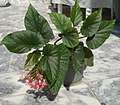 Cracklin Rosie begonia
Cracklin Rosie begonia Cracklin Rosie begonia
Cracklin Rosie begonia
Taxonomy
The genus name Begonia was coined by Charles Plumier, a French patron of botany, and adopted by Linnaeus in 1753, to honor Michel Bégon, a former governor of the French colony of Saint-Domingue (now Haiti).
Phylogeny
The following phylogenetic tree shows the relationships between different sections of the genus Begonia.[3]
| |||||||||||||||||||||||||||||||||||||||||||||||||||||||||||||||||||||||||||||||||||||||||||||||||||||||||||||||||||||||||||||||||||||||||||||||||||||||||||||||||||||||||||||||||||||||||||||||||||||||||||||||||||||||||||||||||||||||||||||||||||||||||||||||||||||||||||||||||||||||||||||||||||||||||||||||||||||||||||||||||||||||||||||||||||||||||||||||||||||||||||||||||||||||||||||||||||||||||||||||||||||||||||||||||||||||||||||||||||||||||||||||||||||||||||||||||||||||||||||||||||||||||||||
Species
Selected species:[4]
Cultivation
The different groups of begonias have different cultural requirements, but most species come from tropical regions, so they and their hybrids require warm temperatures. Most are forest understory plants and require bright shade; few will tolerate full sun, especially in warmer climates. In general, begonias require a well-drained growing medium that is neither constantly wet nor allowed to dry out completely. Many begonias will grow and flower year-round except for tuberous begonias, which usually have a dormant period. During this dormant period, the tubers can be stored in a cool, dry place. Begonias of the semperflorens group (or wax begonias) are frequently grown as bedding plants outdoors. A recent group of hybrids derived from this group is marketed as "Dragonwing" begonias; they are much larger both in leaf and in flower. Tuberous begonias are frequently used as container plants. Although most Begonia species are tropical or subtropical in origin, the Chinese species B. grandis is hardy to USDA hardiness zone 6 and is commonly known as the "hardy begonia". Most begonias can be grown outdoors year-round in subtropical or tropical climates, but in temperate climates, begonias are grown outdoors as annuals, or as house or greenhouse plants.
Most begonias are easily propagated by division or from stem cuttings. In addition, some can be propagated from leaf cuttings or even sections of leaves, particularly the members of the rhizomatous and rex groups.
The following begonia hybrids have gained the Royal Horticultural Society's Award of Garden Merit:-
Horticultural nomenclature
The nomenclature of begonias can be very complex and confusing. The term 'picotee' refers to an edging on the petals that is in contrast to the colour of the main petal, if the colours blend. If they do not, then the term 'marginata' is used, but sometimes these terms are used simultaneously.[13] 'Non-Stop' refers to a camellia tuberous hybrid that under certain conditions will bloom 'non-stop' all year round.
Cultivar groups
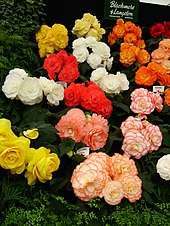
Because of their sometimes showy flowers of white, pink, scarlet, or yellow color and often attractively marked leaves, many species and innumerable hybrids and cultivars are cultivated. The genus is unusual in that species throughout the genus, even those coming from different continents, can frequently be hybridized with each other, and this has led to an enormous number of cultivars. The American Begonia Society classifies begonias into several major groups:
- Cane begonia – forms tough, bamboo-like canes
- shrub-like
- tuberous
- rhizomatous
- semperflorens (wax or fibrous rooted begonias)
- Rex
- trailing-scandent
- thick-stemmed
For the most part, these groups do not correspond to any formal taxonomic groupings or phylogeny, and many species and hybrids have characteristics of more than one group, or do not fit well in any of them.
Culture
The cultivar 'Kimjongilia' is a floral emblem of North Korea.
Most begonias are sour to the taste, and some people in some areas eat them. This is safe in small amounts but potentially toxic in large quantities due to the prevalence of oxalic acid in the tissues.[14]
References
- "Begonia - Welcome".
- David G. Frodin (2004). "History and concepts of big plant genera". Taxon. 53 (3): 753–776. doi:10.2307/4135449. JSTOR 4135449.
- Moonlight PW, Ardi WH, Padilla LA, Chung K-F, Fuller D, Girmansyah D, Hollands R, Jara-Muñoz A, Kiew R, Leong W-C, Liu Y, Mahardika A, Marasinghe LDK, O'Connor M, Peng C-I, Pérez ÁJ, Phutthai T, Pullan M, Rajbhandary S, Reynel C, Rubite RR, Sang J, Scherberich D, Shui Y-M, Tebbitt MC, Thomas DC, Wilson HP, Zaini NH, Hughes M. (2018). "Dividing and conquering the fastest-growing genus: Towards a natural sectional classification of the mega-diverse genus Begonia (Begoniaceae)". Taxon. 67 (2): 267–323. doi:10.12705/672.3.CS1 maint: uses authors parameter (link)
- The Plant List
- "RHS Plant Selector - Begonia (Superba group) 'Irene Nuss'". Retrieved 12 June 2013.
- "RHS Plant Selector - Begonia 'Burle Marx'". Retrieved 12 June 2013.
- "RHS Plant Selector - Begonia 'Marmaduke'". Retrieved 12 June 2013.
- "RHS Plant Selector - Begonia 'Mikado'". Retrieved 12 June 2013.
- "RHS Plant Selector - Begonia 'Munchkin'". Retrieved 12 June 2013.
- "RHS Plant Selector - Begonia 'Orange Rubra'". Retrieved 12 June 2013.
- "RHS Plant Selector - Begonia 'Ricky Minter'". Retrieved 12 June 2013.
- "RHS Plant Selector - Begonia 'Tiger Paws'". Retrieved 12 June 2013.
- Perry, Leonard. "Begonia".
- Laferrière, Joseph E. 1990. On the edibility of begonias. Begonian 57:175.
External links
| Wikimedia Commons has media related to Begonia. |
| Wikispecies has information related to Begonia |
| Look up begonia in Wiktionary, the free dictionary. |
- Chisholm, Hugh, ed. (1911). . Encyclopædia Britannica (11th ed.). Cambridge University Press.
- American Begonia Society
- W. S. Hoover et al. 2004, Notes on the geography of South-East Asian Begonia and species diversity in montane forests
- Phylogenetic Relationships of the Afro-Malagasy Members of the Large Genus Begonia Inferred from trnL Intron Sequences
- A Phylogeny of Begonia Using Nuclear Ribosomal Sequence Data and Morphological Characters
- Begonia L. Plants of the World Online
- Accepted species Plants of the World Online